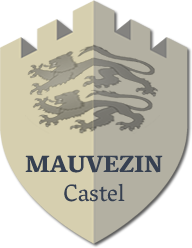Gaston Febus, the Sun Count
When Gaston became Febus
Gaston Febus (1331-1391), the son of Gaston II of Foix-Béarn and Aliénor of Comminges, was born in Foix on April 30, 1331. When his father died during the 1343 crusade in Andalusia, he became Count of Foix and Viscount of Béarn, Marsan and Gabardan. He was 12 at the time.
On one front, he was waging a relentless war against the Count of Armagnac, who had been appointed Steward of the King in Languedoc. During that Southern Hundred Years’ War, Gaston III ravaged the Armagnac lands and took the city of Toulouse under his protection in exchange for a hefty sum, finding for himself a risk-free vocation as a war entrepreneur. The ancestral hatred between the two families prompted them to fight many battles in Languedoc and over the inheritance of Comminges. On December 5, 1362, during the battle of Launac, Febus defeated the House of Armagnac, took a large number of prisoners and received many ransom payments that made him wealthy.
He took advantage of a truce to go fight war in Spain then left during the summer of 1357 to join Teutonic knights going on a crusade in Prussia. On his way back, he set free the Dauphin of France’s wife who had been imprisoned in the market of Meaux and was about to be embroiled in the upheaval of the Jacquerie (June 1358). That feat brought him considerable fame and from that day on, he took on the name of Febus.
A builder and a scholar
That powerful prince was also a wise administrator. He reorganised his estates, set up a permanent tax system, a permanent administration, put together a well-equipped army and organised defence by creating militias and building many forts bearing the prideful motto “Febus me fe”. He developed trade and ensured the safety of traders along the Pyrenees and in the Garonne valley routes. He turned the Morlaas currency into a trading tool that inspired trust all the way to Asia.
A feared prince, he was without a doubt one of the most refined and cultured nobles of his time. He had a magnificent court which drew visitors from all Europe. A lover of the arts, he wrote the Book of Prayers and the Book of the Hunt. He sent for and had many manuscripts translated, including Albucasis’s work and the Elucidari. The chronicler Froissart went to the court in Orthez and wrote some of his best work there.
The creation of the Nebouzan
In 1360, the Treaty of Brétigny ceded Bigorre to England. But in 1368, the Bigorre lords rebelled. Only the castles of Lourdes and Mauvezin resisted. As a result, the Duke of Anjou, brother to King Charles V, laid siege to Mauvezin Castle in 1373. In 1379, after the war of succession in Comminges, Febus received the castellanies of Goudon and Mauvezin. He added his lands to the castellanies of Lannemezan, Sarramezan, Saint-Gaudens, and Cassagnabère and gave birth to Nebouzan. In 1391, he also added the castellany of Sauveterre de Comminges.
His glory was tarnished by the tragedy of Orthez in 1380. Under obscure circumstances, he killed his only heir Gaston, who was being secretly manipulated by his stepbrother Charles the Bad, King of Navarre. That event caused Febus immense grief. He






















